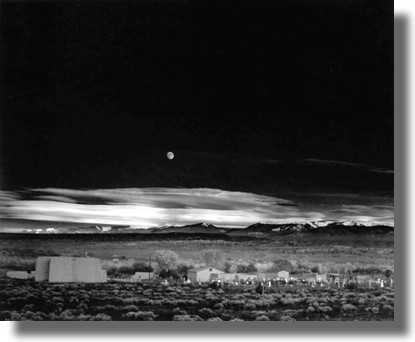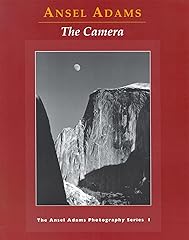Ansel Adams
Moonrise Hernandez
New Mexico, 1941
Moonrise Hernandez, is Ansel Adams most popular single image.

The making of the picture
View price and framing optionsIt was taken at the end of a day when Adams had been taking photographs in the Chama Valley, north of Santa Fe, New Mexico.
There had been frustrations earlier in the day when he had tried to capture images that he saw in his minds eye, but due to the precise arrangement of background and other objects, was unable to render a satisfactory rendition on a negative.
To all intents and purposes the day's photography was over and it was while driving home southward along the highway near Espanola that Adams happened to glance sideways out of the car window and saw the scene that was to become this photograph.
He quickly stopped the car and set up his 8" x 10" view camera, with the aid of his companions he arranged his lens, a suitable filter and was ready to take the exposure when he realized that his exposure meter was nowhere to be seen. Time was running out - at sunset the scene changes rapidly - soon the light in the clouds would start falling off and the highlighted white crosses would soon dim.
Experience saved the day as Adams took the value for the brightness of the moon that he knew from previous measurement and experience and applied his "zone" system of exposure to various aspects of the scene that his master touch had perfected. He decided on an exposure of a second with ASA 64 film at f/32. He also made a note of the type of development that he would subject the negative to once it was back safely in his darkroom.
Intending to take a duplicate negative as he appreciated the uniqueness of the scene Adams attempted to set up again, but it was too late. Just as he was getting ready with a second negative plate, the sunlight passed from the crosses and the precise lighting effect of the scene was lost.
The development of the negative was a painstaking process, being carried out very slowly to give the maximum control of the image. The resulting negative was difficult to print and several years after it was taken the foreground was subjected to a process of chemical "intensification" that altered it in a way whereby "Printing was a bit easier thereafter, although it remains a challenge".
The printing of the image was also in itself a highly skilled task with different areas being "masked" and given more or less exposure than others until the overall balance of tones was one that resulted in a satisfactory image. Even differences in batches of what were supposedly exactly the same type of photographic paper were noticed, a result of all the variables involved led to the comment, "It is safe to say that no two prints are precisely the same".
Despite his enormous attention to detail in taking his photographs, developing the negatives and then in printing those negatives, Adams was surprisingly vague about the actual date when he took this picture. At various times it was quoted as being taken anywhere between 1940 and 1944!
The debate was eventually settled after a computer analysis of the scene and precise position of the moon gave an answer of approximately (!) 4:05 p.m. on October the 31st 1941.
It is a picture that Adams was clearly pleased with in that it attracted much admiration and comment from others. It represents a fine example serendipity of the scene combined with his technical methods, knowledge and skills in producing the picture from the initial exposure of the negative to the final "difficult" printing process.
Moonrise Hernandez
by Ansel Adams
View price
and framing options
Bibliography - Examples: The Making of 40 Photographs by Ansel E. Adams






